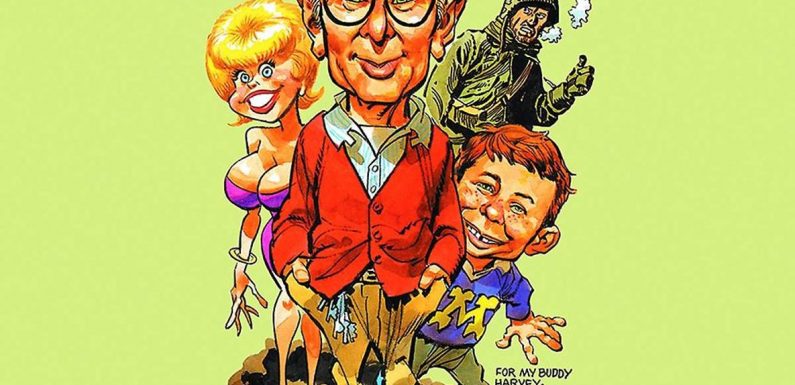

Harvey Kurtzman is a genius — that’s really all there is to it. Well, rather, there’s slightly more to it — “was”, considering he died not quite 25 years ago. And, well, sure just merely calling him a genius does sell him a little short, I suppose — it doesn’t bring up his fluid art style, his war comics which were the first to not glamorize war as all the others did, and he created Mad, which is pretty much a feat in itself. The Comics Journal had done a series of interviews with him, and this book compiles them (along with a couple of other earlier interviews, comics and essays). We can find out Kurtzman’s points of view on French comics (pro), being false in your work (con) and on the continuing decision to do Little Annie Fanny in paint rather than ink (mixed). Kurtzman also tells us about the genesis of the name “Mad”, the origin and naming of Alfred E. Neuman, and his views of business versus art.
Unfortunately, he tells us these things over and over again. Granted, that’s a product of the construction of the book — several interviews brought together — though I wonder if it’d have been almost better to compile the interviews into a long faux-conversation, to get to the new material without having to rehash the same questions over and over (which were, of course, new in the interviews’ original context, being in a stand-alone magazine rather than a book all on one subject). It is an admittedly minor nit, and that’s why we’re given the ability to opt to scan some things rather than read every single word as if it were gold… though the sum of these words is almost as good as that particular yellow, soft substance. (Not chicken fat.)
The repetition is not limited to just the subjects, though — sometimes the same visuals are used a few times throughout the book — certain covers of Frontline Combat and Mad are peppered throughout the book (notably the “Armistice? Tell that to Johnny!” cover and the Basil Wolverton “Beautiful Girl of the Month” cover, respectively). I also found the use of single pages of stories to be a little frustrating — sure, they show a great quality of Kurtzman’s work… that’s why I wanna see the rest of it! But then again, rights for a single page or panel are much easier to wrangle than entire stories, so I can’t really fault Fantagraphics for that (though, the outstanding “Big If” story is printed in its entirety along with a critical essay on the piece, which does slake that thirst a bit for full works). I suppose what we need is a companion volume with the full stories talked about… or even better, a publisher to work on getting all of Kurtzman’s work back in print (Russ Cochran at Gemstone’s taking the lead on getting the EC stuff available again… anyone else want to take the other stuff?), so we can see the complete work of a cartoonist’s cartoonist, an influence on so many people, from the Underground Comix Scribes to musicians and creatives of all stripes.
Although, as I’ve pointed out, this book isn’t flawless — it’s still an essential look at Harvey Kurtzman and his work and motivations. For anyone who is interested in comics, satire or just plain art and storytelling, knowledge of Kurtzman is required, and this is a fine place to get that information. (And you get a couple of strips by R. Crumb and Art Spiegelman in the process, so who can complain?)
Kittysneezes is supported by readers like you. If you enjoy what you’ve read here, please consider supporting us on Patreon.
Previously published June 11, 2007